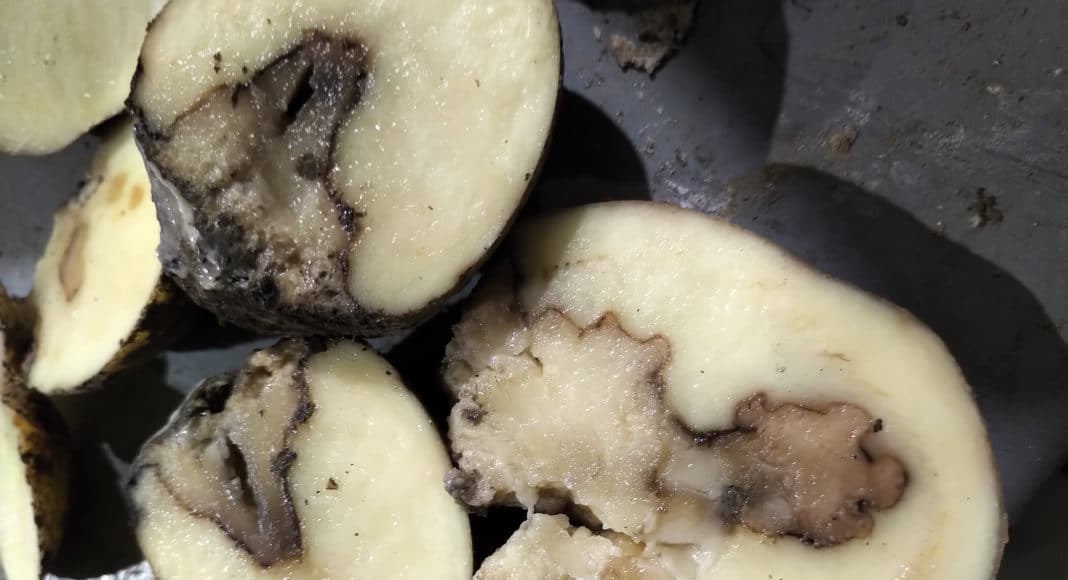Last spring, I was wondering whether the incidence of Dickeya dianthicola was expected to be high in 2020, so I reached out to Steve Johnson at the University of Maine. To my surprise, he said he was more concerned about Pectobacterium parmentieri than Dickeya. According to Johnson, “other members of the Pectobacterium genus are present and continue to cause disease, but not to the catastrophic level has been associated with field and storage losses in Maine”.
P. parmentieri is not a new pathogen — it was found in Europe in the 1960s but reported under a different name. Molecular techniques have made it possible to classify pathogens based on genetic characteristics, and there have been a lot of name changes. P. parmentieri was first reported in Maine by Johnson in 2016. The Canadian Plant Disease Survey has also reported it in Canada — it is not a quarantinable pathogen.
Symptoms: Parmentieri can cause tuber soft rot and blackleg. Affected plants are wilted and stunted with black soft rot extending upwards from the mother tuber. Contamination of foliage can result in aerial stem rot. The symptoms are very similar to those caused by the common soft rot bacterium, common blackleg and Dickyea. At the recent virtual Idaho Potato Conference, Ken Frost, a plant pathologist with Oregon State University, said Parmentieri is a lot more aggressive than the common tuber soft-rot pathogen, he called it a “better tuber rotter.”
Source of inoculum: The bacterium is found in the seed, usually at the stem end of the tubers or in and around the lenticels. Lenticels open when the soil is too wet providing an entry point for bacterial pathogens. Asymptomatic tubers may harbor Parmentieri in a dormant state like Dickeya. Steve Johnson mentioned there is no evidence that Parmentieri survives in the soil in Maine.
Disease Development: Infected seed can break down in the field reducing stands. Stems which do emerge are often weak with wilted foliage. These plants then spread the disease to healthy plants nearby. Parmentieri develops most rapidly during warm, wet summers and often kills the entire plant.
Disease Spread: Parmentieri can spread in the field below-ground, when water moves in soil saturated by rain or irrigation. Infected tubers contaminate harvesting and handling equipment. The infested equipment can transfer bacteria to tubers dug from healthy fields. The infected asymptomatic tubers may show no soft rot and may not decay in storage because of the low temperatures. However, the bacteria are likely to cause and spread disease if such tubers are planted.
I found Parmentieri during the 2020 season. The incidence of blackleg was high and spread rapidly in a field where there was good soil moisture for the whole growing season. Parmentieri was confirmed from a sample of infected tubers I sent to a CFIA accredited lab. The hot spots were flagged and not dug, the crop was marketed from the field. This is an excellent strategy to follow when dealing with aggressive pathogens.
Management
Integrating a disease management strategy throughout the entire potato planting, growing, and harvesting cycle is the key to mitigating losses from Parmentieri:
- Plant certified seed
- Grade seed carefully and grade out suspicious tubers
- Disinfect seed cutters often
- Avoid bruising and damage during planting and harvest, as well as during the loading of storage bins and shipping trucks, to reduce the risk of disease
- Avoid harvesting wet fields or tubers with pulp temperatures higher than 65 F, and promote rapid drying of harvested tubers.
- Disinfect the potato handling equipment between lots. Potato handling equipment is anything which handles the potatoes, harvesters, windrowers, truck bodies, bin pilers, seed racks, and the like are included.
This information is based on Bulletin #2448 (University of Maine Cooperative Extension) authored by Steven Johnson.











